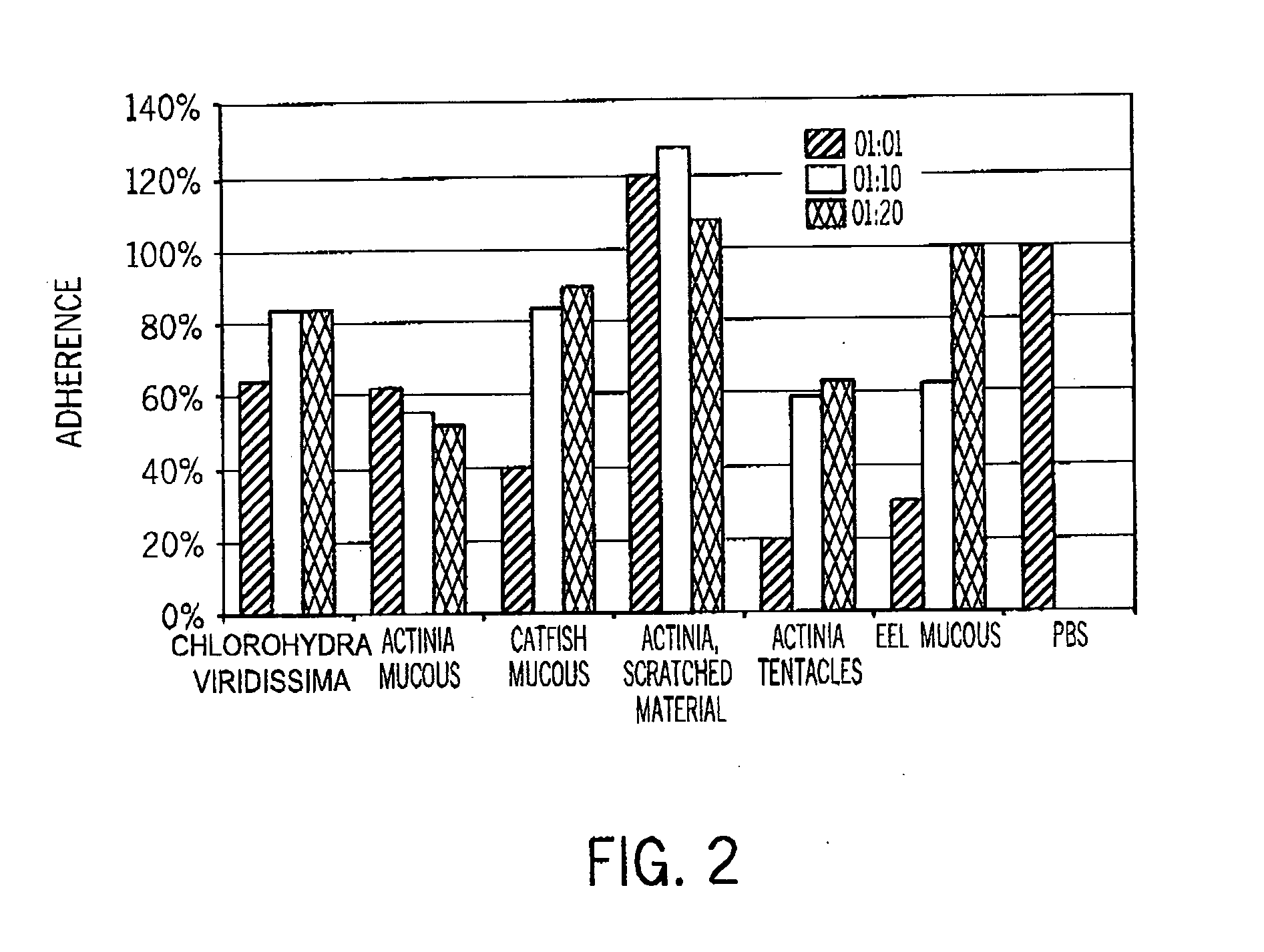Compositions of aquatic origin for prevention of cell adhesion and methods of using same
a technology of cell adhesion and composition, applied in the field of extracts of aquatic organisms, can solve the problems of complex composition of biofilms, ineffective doses of antibiotics which normally kill organisms in suspended cultures, and inability to prevent or reduce the adhesion of organisms to a surface, and achieves the effect of preventing or reducing the adhesion of organisms to a surface, and devoid of cytotoxic or cytostatic activity
- Summary
- Abstract
- Description
- Claims
- Application Information
AI Technical Summary
Benefits of technology
Problems solved by technology
Method used
Image
Examples
example 1
Fish and Cnidarians Crude Extracts Act in an Anti-Adhesive Manner
[0240]Materials and Other Experimental Organisms
[0241]Cnidarians and Other Experimental Organisms
[0242]Cnidarians and other experimental organisms including the sea anemones Actinia equina and Aiptasia pulchella as well hydroids Chlorohydra viridissima and Hydra vulgaris were grown and maintained in the laboratory or collected directly from their natural habitat.
[0243]Sample Collection
[0244]Samples were collected from surface mucous of fish (eel, catfish) and homogenates of sessile cnidarians (from two kinds of hydrae and sea anemones). Briefly, 300 mg wet weight of anemone tissue were dissected, rinsed in distilled water (DDW), homogenized in a volume of 300 μl DDW (total volume of about 500 μl), centrifuged (3 min, 14000×g) and prefiltered (0.2 μl).
[0245]Bacteria Growth
[0246]All bacteria strains were grown in triplicates for individual experiments. Acinetobacter baumanni, Staphylococcus aureus, Pseudomonas aurigenose...
example 2
Actinia equina Extracts Function as an Anti-Adhesive But Are Not Bacteriocidal
[0252]Materials and Experimental Procedures
[0253]Actinia equina
[0254]The sea anemone Actinia equina was grown and maintained in the laboratory.
[0255]Sample Collection
[0256]Homogenates of sessile cnidarians (Actinia equina) was collected. Briefly, 300 mg wet weight of anemone tissue were dissected, rinsed in distilled water, homogenized in a volume of 300 μl DDW (total volume of about 500 μl), centrifuged (3 min, 14000×g) and prefiltered (0.2 μl).
[0257]Column Chromatography and Protein Chemistry
[0258]Samples (100 μl) were separated on an analytical C8 (Thermo-Hypersil, Keystone) or C-18 (Vydac) column, eluted by a linear gradient of acetonitrile in DDW+0.1% Trifluoroacetic acid (TFA, 3-80% from 5 to 75 minutes). The elution pattern was monitored at 215 nm.
[0259]Bacteria Growth
[0260]As described in Example 1.
[0261]Bacterial Adherence Bioassay
[0262]As described in Example 1.
[0263]Bacterial Killing / Growth Inh...
example 3
Actinia equine Crude Extract Effects Initial Stages of Biofilm Formation
[0274]Materials and Experimental Procedures
[0275]Actinia equina
[0276]The sea anemone Actinia equina was grown and maintained in the laboratory.
[0277]Sample Collection
[0278]Homogenates of sessile cnidarians (Actinia equina) was collected. Briefly, 300 mg wet weight of anemone tissue were dissected, rinsed in distilled water, homogenized in a volume of 300 μl DDW (total volume of about 500 μl), centrifuged (3 min, 14000×g) and prefiltered (0.2 μl).
[0279]Bacteria Growth
[0280]As described in Example 1.
[0281]A High-Throughput Polystyrene Microplate Assay
[0282]Various bacteria (e.g., S. aureus ATCC 25923) were grown in 96-well round-bottom polystyrene plates. After 24 hours of incubation at 37° C., each well was washed with water and stained with 250 μl crystal violet solution. The dye was removed by thorough washing with water. For quantification of attached cells, crystal violet left in the wells was solubilized in...
PUM
| Property | Measurement | Unit |
|---|---|---|
| peak mass | aaaaa | aaaaa |
| peak mass | aaaaa | aaaaa |
| peak mass | aaaaa | aaaaa |
Abstract
Description
Claims
Application Information
 Login to View More
Login to View More - R&D
- Intellectual Property
- Life Sciences
- Materials
- Tech Scout
- Unparalleled Data Quality
- Higher Quality Content
- 60% Fewer Hallucinations
Browse by: Latest US Patents, China's latest patents, Technical Efficacy Thesaurus, Application Domain, Technology Topic, Popular Technical Reports.
© 2025 PatSnap. All rights reserved.Legal|Privacy policy|Modern Slavery Act Transparency Statement|Sitemap|About US| Contact US: help@patsnap.com



